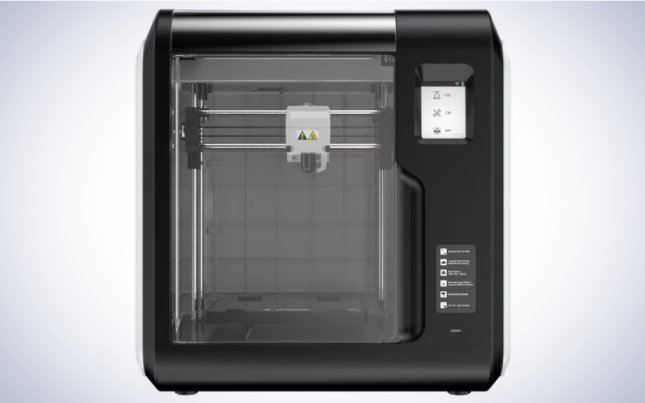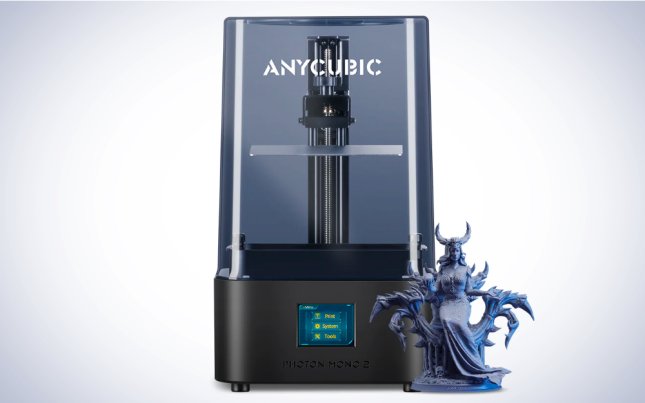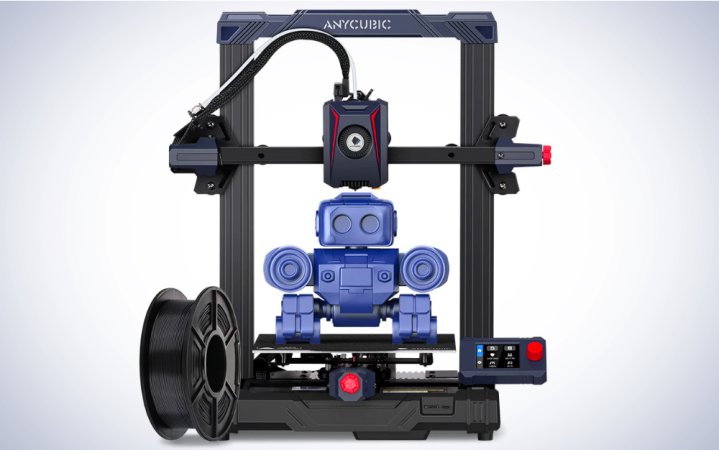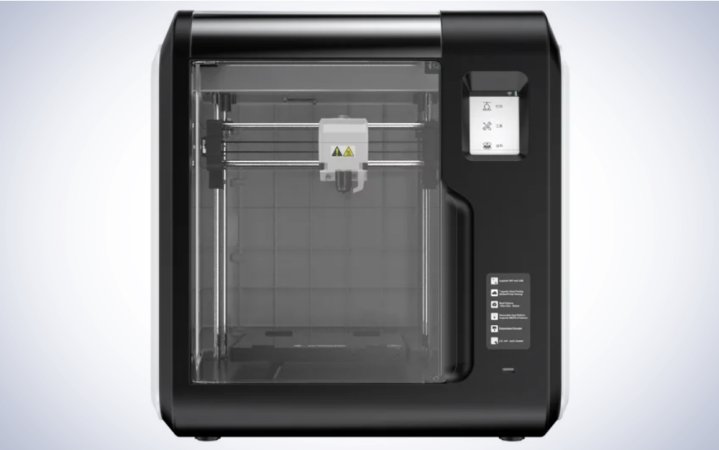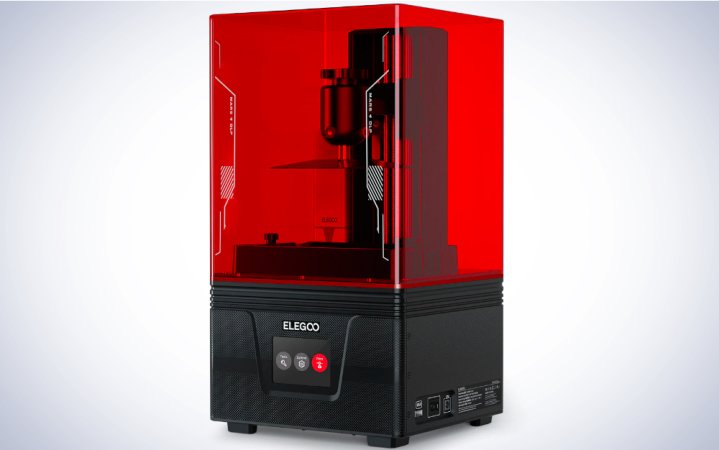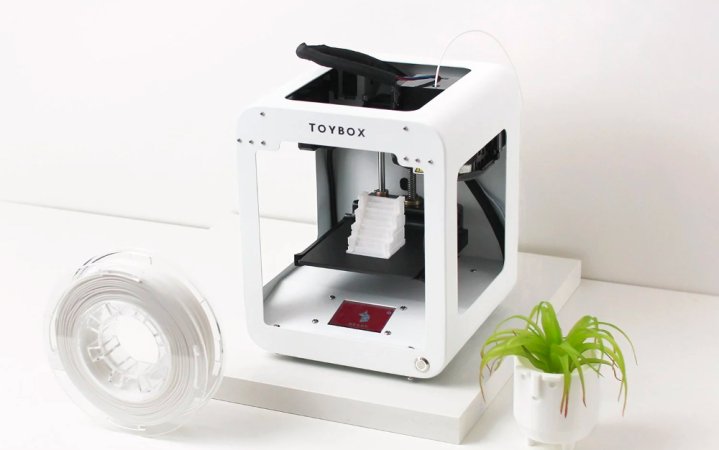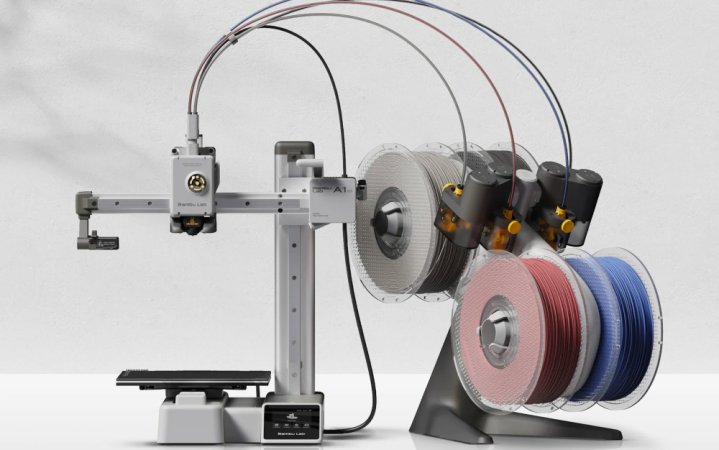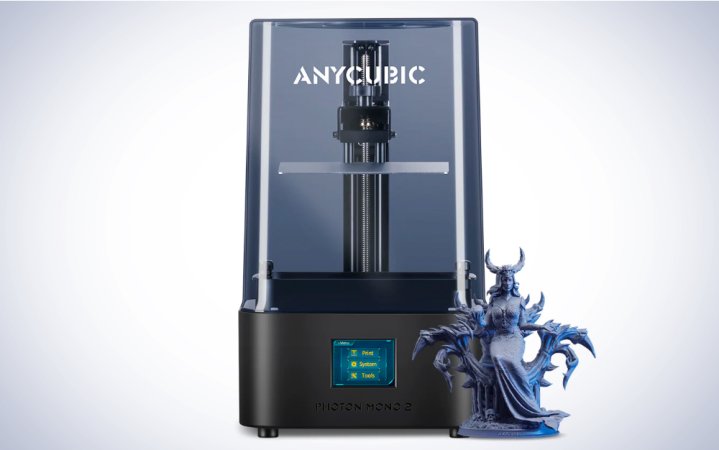We may earn revenue from the products available on this page and participate in affiliate programs. Learn more ›
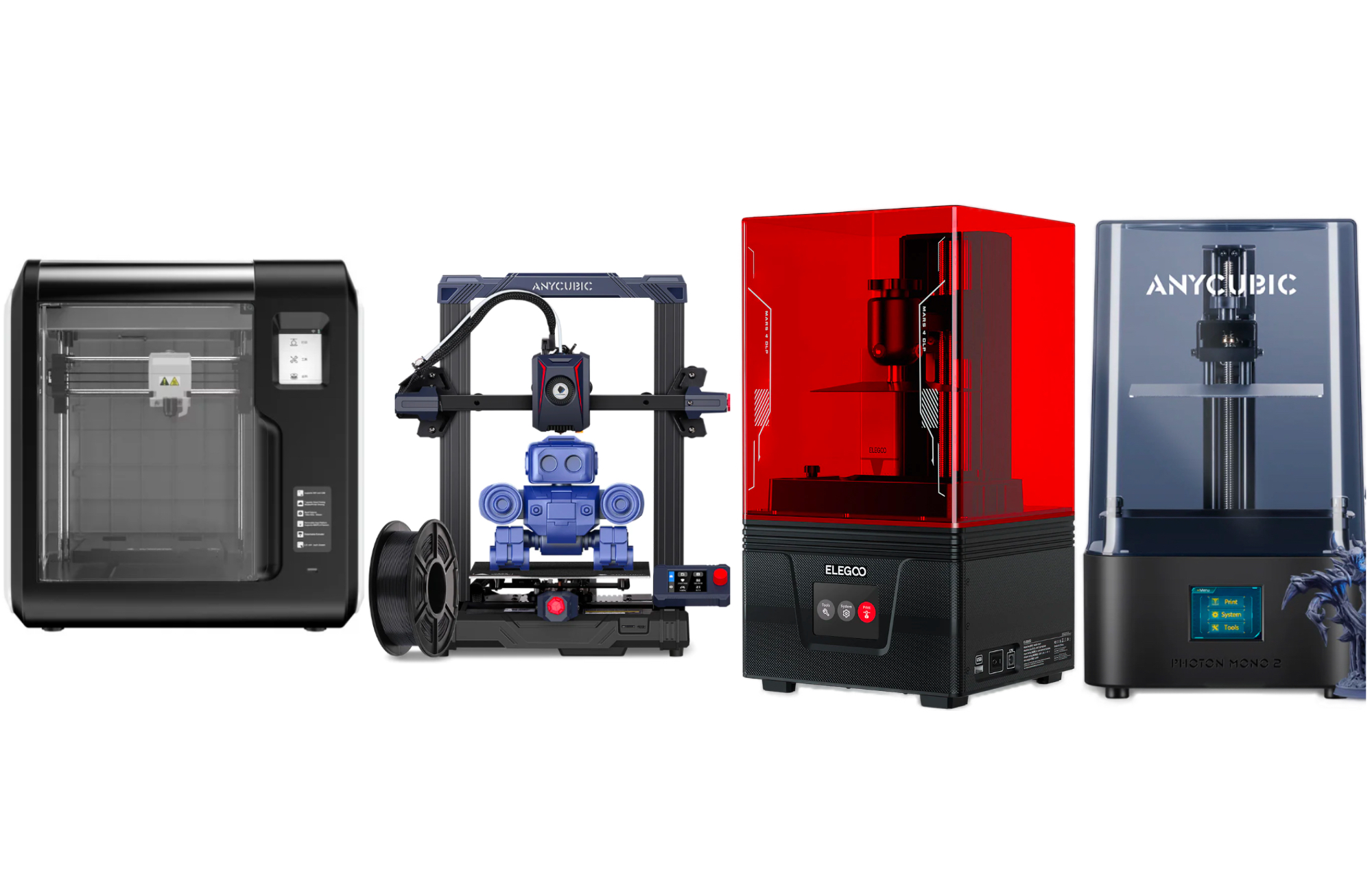
Nowadays, if you plan things right, you can get a budget 3D printer for less than some regular printers cost. It may seem weird, but it’s true. If you understand how 3D printing works, you’ll begin to see that—for some 3D printers—the components are not nearly as technical and hard to make as the engineering behind them, such as the calculations for how to print and the software that goes inside the machine. That’s not the case for all 3D printers, but you will find that most of the best budget 3D printers print quality designs with relatively simple bodies.
- Best overall: Anycubic Kobra 2 Neo 3D Printer
- Best enclosed: Flashforge Adventurer 3
- Best resin: Elegoo Mars 4
- Best for beginners: Toybox 3D
- Best designed: Bambu Lab A1 Mini
- Best for small objects: Anycubic Photon Mono 2
How we selected the best budget 3D printers
Most of our budget 3D printers were chosen from our past research and for their success in their given category. By this, we mean that our favored resin 3D printer was already a renowned resin 3D printer; it also happened to be budget. So you’ll find links to several of our previous 3D printer roundups if you want to delve deeper into the types of printers or explore what paying more might provide.
Near the end of this article, we will discuss the particulars of picking out the best budget 3D printers on your own. What should be mentioned now, before this begins, is how we are defining “budget 3D printers.” Budget 3D printers, for the sake of this article, are printers capable of making high-quality prints that also happen to have a lower cost than most printers in their category. They may still cost hundreds, but they’re a bargain compared to their brethren. None of the printers on this list are cheap imitations, and reliable brands make them all.
The best budget 3D printers: Reviews & Recommendations
As we explore each option, we will look at products that create good prints but may have something “missing” compared to a premium pick. But all our picks have a lot going for them when you consider the price. Use these product investigations to guide the budget level you can tolerate and if a given product can service your needs.
Best overall: Anycubic Kobra 2 Neo 3D Printer
Anycubic Kobra 2 Neo 3D Printer
Pros
- Auto-leveling beds
- Easy assembly
- Smooth line exteriors
Cons
- Large print-volume-to-size ratio
Specs
- Type: FDM
- Printing volume: 9.8 x 8.7 x 8.7 inches
- Printer size: 19.1 x 17.3 x 17.3 inches
- Exterior: Unenclosed
The Anycubic Kobra 2 Neo 3D Printer is consistently recommended as one of the best 3D printers for just about anybody, yet it comes in at a surprisingly low price, even touching below the $200 mark when on sale. One of its nicest features comes from a pair of features called “linear propulsion and input shaping functions” by Anycubic. In essence, the Kobra 2 Neo focuses on print edges (especially in the horizontal plane) in a way that makes its prints pull the appearance of a resolution way above its paygrade.
Using the Kobra 2 Neo is surprisingly easy as well. It has five total pieces that can be easily assembled, taking up a small area before this assembly. It auto-levels and has a dial-based digital interface. Note that the filament holder sticks out quite far, however, making the ratio of printer space to printing space quite high. This, combined with its frameless, unenclosed exterior, means that you’ll likely want to dedicate a special table for your Anycubic Kobra 2 Neo 3D Printer to live on.
Best enclosed: Flashforge Adventurer 3
Flashforge Adventurer 3
Pros
- Plug-and-play setup
- Tried and true model
- Built-in HD camera
Cons
- Slow print speeds
Specs
- Type: FDM
- Printing volume: 150 x 150 x 150 mm
- Printer size: 22 x 22 x 22 inches
- Exterior: Enclosed
In the world of the best budget 3D printers, one way to find a great bargain is the hot model of yesteryear that still works well today. One such printer is the Flashforge Adventurer 3, one of the best enclosed 3D printers, which has since been improved upon by the likes of the Flashforge Adventurer 4 and 4 Pro. The older 3 model is just as good as it was back then, and quite better if the main factor you look at is price.
Due to its enclosed design, it is more or less plug-and-play. Within, you’ll find an HD camera to let you see what’s happening inside. This is great, as it allows inspection of the print’s first layer, the one most likely to have issues. In fact, the only issue we really anticipate you having with this printer—most users from this printer’s long history have only reported good things with continued usage—is that the print speed is somewhat slower than newer models.
Best resin: Elegoo Mars 4
Elegoo Mars 4
Pros
- Includes gloves, scraper, tools, etc.
- 20,000-hour lifespan
- High-resolution prints on the cheap
Cons
- Resin printing is more difficult than FDM
Specs
- Type: Resin
- Printing volume: 132.8 x 74.7 x 150 mm
- Printer size: 246 x 230 x 453 mm
- Exterior: Enclosed
To create something with a higher degree of resolution, you may find yourself wanting something like the Elegoo Mars 4. Depending on settings, it has a layer thickness that can go as low as 0.01mm and an XY resolution of 0.05mm (2560 x 1440p on its screen) to give you a cutting-edge print with tons of control.
We particularly like how it comes with almost everything you need to print, including a scraper, adjusting tools, and gloves. This complete bundle of included items, combined with the estimated 20,000-hour lifespan of the LED light source needed to harden the resin, makes this the best value budget 3D printer you can find.
Please remember this is one of the best resin 3D printers, meaning it will naturally be a bit trickier than most budget 3D printers. For one, you’ll need to supply it with 3D printer resin, which is more difficult to use than spools of plastic. You’ll also need to cure the prints. Keep reading for a better budget 3D printer suitable for rank-and-file beginners.
Best for beginners: Toybox 3D
Toybox 3D
Pros
- User-friendly interface
- Simple setup
- Prints “just work”
Cons
- Some features gated behind membership
- Small print volume
Specs
- Type: FDM
- Printing volume: 7 x 8 x 9 cm
- Printer size: 7.4 x 7.4 x 9.05 inches
- Exterior: Framed
Though the Toybox is marketed to kids, we’re billing this as a great printer for just about anybody and an excellent 3D printer for beginners. As you’ll see in our Toybox 3D Printer review, the initial setup is overall simple, but there are a couple of places where the process could be made clearer for the overly cautious first-timer.
You’ll also find that once you’re ready to go, everything more or less “just works.” The website guides you through making prints in such a way that you don’t need to overthink anything, and we estimate that you can sort of wander through the process of unboxing and arrive at a usable print (try the whistle for a quick one) within an hour, possibly shorter.
Then, once you’ve felt your way around this small 3D printer, more advanced options will begin to stand out, including pulling in print files from outside sources and using Toybox’s slicer programming. In other words, from the very first print, you’re slowly being guided to the intermediate level of 3D printing mastery.
Best designed: Bambu Lab A1 Mini
Bambu Lab A1 Mini
Pros
- Pre-assembled, tuned, and squared
- Multi-spool usage for multi-colored prints
- Includes 1080p camera with timelapse
- Comes with six months of Bambu Filament Membership
Cons
- Low stability
Specs
- Type: FDM
- Printing volume: 180 x 180 x 180 mm
- Printer size: 347 x 315 x 365 mm
- Exterior: Unenclosed
For an advanced 3D printer that does the work but doesn’t cost too much, take a look at Bambu Lab’s A1 Mini. It features a multi-spool design that works straight out of the box, letting you utilize several colors in a single print, bringing a whole new dimension to the craft.
As you’re experimenting with making your own multi-colored 3D prints, you are likely to make mistakes, as beginners of anything new tend to do. Figuring out what went wrong from the finished print is always possible, but with the Bambu Lab A1 Mini, you’ll be able to see a timelapse of your creation and see exactly where things went wrong. Or, should everything go right, you’ve got a cool time-lapse video to pop up on YouTube.
Ultimately, this is a very advanced printer that is made with bare-bones materials. While this keeps costs down, you may find that the structure lacks heft and stability compared to premium models with similar capabilities.
Best for small objects: Anycubic Photon Mono 2
Anycubic Photon Mono 2
Pros
- 4K resolution prints
- Avoids grid lines
- Includes gloves, spatula, etc.
Cons
- No auto-leveling
Specs
- Type: Resin
- Printing volume: 6.5 x 3.5 x 5.6 inches
- Printer size: 15.4 x 9.01 x 9.25 inches
- Exterior: Enclosed
If you aim to make small 3D prints for cosplay or create cool 3D-printed miniatures for your next roleplaying session, going for a printer that provides intricate details, but the small scale might be perfectly up your alley. As such, we recommend a smaller resin printer that makes high-resolution prints on a smaller scale.
When resin printers print, they use light from an LCD screen to trigger a hardening process in the resin. As a result, many such printers leave behind grid lines. This printer’s design avoids that flaw, at a low price. You’ll also find high value in the included parts, which include gloves, a spatula, a funnel, and more that you need to get started with 3D printing in resin.
What to consider before buying one of the best budget 3D printers
For any given 3D printer category, there will be many parameters and specifications to get right before a certain printer becomes a “buy.” Our product investigations above should give you a good idea of how to evaluate a budget product from several categories, as well as provide good links to more information. However, some considerations when buying 3D printers are more universal or generally valued. Here, we break the most important of those categories down in the context of finding one of the best 3D printers.
FDM vs. Resin
The first essential question in any 3D printer search is whether you should get an FDM printer that prints out in plastic via spools or a resin 3D printer. Fortunately, it is not a difficult question to answer.
If you’re like most customers on the hunt for the best budget 3D printers, you should buy an FDM printer that uses spools of plastic to print, not liquid resin. The reasons for this are three-fold:
- They’re cheaper in nearly every case.
- They’re better and safer for beginners.
- They require less knowledge, skills, preparation, and expertise to get right.
- When using them, you can generally get a good print right away.
Resin 3D printers create quality prints with good resolutions, but they require a curing process, gloves for safe handling, proper storage and resin usage in a dark room (light begins the hardening process), and more. Plus, they’re typically more expensive, even at the budget level. Some of the best budget 3D printers are, indeed, resin 3D printers, but they’re included for experienced hands that have come here specifically looking for them.
Bottom line: If you’re doing more than skimming this section or haven’t heard about the two types of 3D printers before, we strongly suggest you go with an FDM-style printer.
Printing volume
Next, you’ll want to ask yourself about the size of your idea prints. This is one area where the best budget 3D printers do not have to sacrifice anything. In some ways, this makes a lot of sense. The print head, gear mechanisms, and software take the brunt of a 3D printer’s costs; scaling it outwards is just a small bit extra. On the other hand, it can also make sense to cut costs by keeping a printer smaller, especially if the printer uses an enclosure (more on enclosures in a moment).
All of this being said, be wary of budget 3D printers that are very tiny, have off-brand labeling, and resemble Easy-Bake Ovens. Quite prolific on Amazon and similar retailers, these are great ways to lose $200 or so on an inferior product.
Printer size
Where you are likely to see size come into play in budget models is the size of the overall model. A budget model can, at times, become paradoxically big as the machinery is not as compact or efficiently built like more expensive models. Check to ensure you have the dedicated room for your budget printer before purchasing it.
Exterior (enclosures)
Finally, consider if you want an enclosure or not. Typically, we think of enclosures in the binary: a 3D printer either has one or not. Here, however, we look at three styles of exterior:
- Enclosed — Fully enclosed 3D printers block air from vents, which can alter filament temperature at the moment of extrusion. Additionally, they provide structure for the printer as the extruder moves about. Resin printers are enclosed by default, due to the nature of their printing process.
- Framed — This type of printer has a box-like frame but no solid enclosure. Provides stability and some protection but does not protect against ambient air temperature changes.
- Unenclosed — Totally unenclosed, with no frame. Can somewhat help combat common odors from 3D printing.
In normal circumstances, “framed” and “unenclosed” 3D printers are rolled into one category. We make this somewhat unique distinction due to the landscape that is budget 3D printers, where completely unenclosed printers are more common than in other categories.
Furthermore, we find that utilizing an enclosure on a 3D printer, and especially a (relatively) lower resolution budget 3D printer, is overhyped. Even a child/teenager’s 3D printer like the Toybox can produce consistently formed prints at the ‘framed’ level. If you ever need an enclosure, you can always put something over your 3D printer to DIY an enclosure at minimal extra cost.
Finally, since the distinction between framed and unenclosed is being made here, it should be noted that framed 3D printers offer some protection. Imagine a busy hobby room with wood dowels, rulers, and other long objects being moved about. A frame will prevent unnecessary knocking of the print and extruder.
FAQs
A high-quality budget 3D printer will likely cost, at minimum, $200 unless other discounts are applied. Be wary of 3D printers at or under this price unless they come directly from a reputable brand. Also, note that some printers that cost several hundred dollars more can still be considered “budget” if they are of a certain type or hold specific features on the cheap.
It is not hard to 3D print, though some printers are easier to use than others. You’ll definitely want an FDM printer that uses filament for an easy-to-use 3D printer, as resin 3D printing takes extra steps to “cure” the print, some of which use toxic materials. One of the most important factors in determining how easy or difficult a 3D printer will be to use is, surprisingly, its interface. With FDM printing, you’ll do very little after getting your printer started beyond watching the first layer form.
The best budget 3D printers are expected to last a long time. Part of this is because many of the best budget 3D printers are just older models that have lost MSRP pricing over time. We already know they last a while! Software and file types don’t change as much over time with 3D printers as they do with apps on your phone or computer, leading to a longer lifespan.
Final thoughts on the best budget 3D printers
- Best overall: Anycubic Kobra 2 Neo 3D Printer
- Best enclosed: Flashforge Adventurer 3
- Best resin: Elegoo Mars 4
- Best for beginners: Toybox 3D
- Best designed: Bambu Lab A1 Mini
- Best for small objects: Anycubic Photon Mono 2
The aforementioned printers are an excellent way to get into the world of 3D printing on the cheap, but that doesn’t make them cheap 3D printers that will disappoint. In fact, if you are beginning the hobby or are introducing it to a group—such as a student club—the best budget 3D printers should be able to service you for many years. These are low-hesitation pickups on your road to 3D printer mastery.

